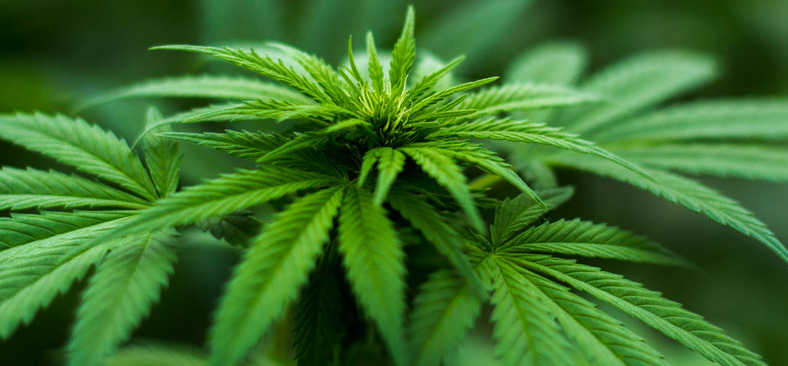Herbal Evidence
Do cannabinoids help to reduce pain?
Cannabis and pharmaceutically derived cannabinoids have been studied for their effects on pain for decades, but do they work as pain remedies?
Last updated: 15 May 2020

What are cannabinoids?
Cannabis is a plant comprising hundreds of compounds including the psychoactive tetrahydrocannabinol (THC), the non-psychotropic cannabidiol (CBD) and other cannabinoids. Cannabis can be consumed in many ways including via smoking, vapour and oil extracts. There are also pharmaceutically derived cannabinoids in the form of sprays and capsules, such as nabiximols and dronabinol.
Cannabis has been used medicinally and recreationally for millennia and continues to be used today by millions of people globally. The medicinal uses of cannabinoids have been formally investigated for a range of conditions including as a herbal pain relief.
Understanding pain
Pain is an unpleasant sensation that may be experienced in many parts of the body. It may be short-lived and resolve quickly (acute) or the pain may be chronic, lasting at least 3 or 6 months. Causes include injury and conditions such as cancer and multiple sclerosis. Pain is notoriously hard to measure and, being subjective, it is hard to compare one person’s level of pain to another’s or to an objective threshold. Therefore, studies investigating pain typically define the treatment’s success by looking at changes in pain severity within a patient. For example, a patient may be asked prior to receiving treatment to rate their pain on a scale from 0 to 10, where 10 is the worst imaginable pain. After treatment, the patient would be asked to rate their pain again and a reduction in the score, of say at least 30%, would indicate an improvement. So, a patient who initially rated their pain at a 10 and later rated it as either a 7 or lower would be seen as having a positive outcome.

Pain clinical trials testing cannabinoids
After a systematic review of the literature, Herbal Evidence extracted the results from two dozen randomised controlled studies of cannabinoids treating pain. Overall, there is strong evidence that cannabinoids work better than placebo in improving pain outcomes for a range of patient groups and forms of treatment.
One group of researchers have investigated vaporised cannabis to treat neuropathic pain (such as due to spinal cord injury or diseases) and found that when given cannabis most patients experienced at least a 30% reduction in pain scores (61% (1) and 88% (2)) compared with under 50% when given placebo (26% and 45%, respectively). Similarly, in one study of HIV patients (3) 52% of those assigned to smoking cannabis cigarettes (3.56% THC) experienced at least a 30% reduction in their pain scores compared with 24% of those smoking placebo cigarettes. This suggests that cannabis may be successfully used as a natural pain remedy.
Pharmaceutically derived cannabinoids in a number of forms have also been investigated, including a cannabis extract mouth spray (Nabiximols; tradename Sativex) and synthetic forms of THC in capsules (such as Dronabinol and Nabilone). While some of these clinical trials have not shown promise for alleviating pain (for example, Dronabinol studies in multiple sclerosis patients (4) and chronic pain (5)) some Nabiximols studies have shown promise. For instance, in one study of multiple sclerosis patients (6), 71% of patients given Sativex experienced an improvement compared with 31% who were given placebo and in patients with cancer-related pain (7), 43% on Sativex experienced a benefit compared with 21% on placebo. On the other hand, other Nabiximols studies have shown less impressive (8) or more marginal differences (9) compared with placebo. However, the overall findings of our meta-analysis show that patients given cannabinoids were more likely to experience a pain reduction compared with those given placebo.
For information on all the studies included in the meta-analysis, go to the cannabinoids page, select “Pain” as the condition and download the related PDF fact sheet.
So, should I take cannabinoids for my pain?

As the above demonstrates, patients receiving some form of cannabinoid in clinical trials had an increased chance of experiencing improvements in their pain compared with those receiving placebos. However, not every patient given cannabinoids experienced a pain reduction and, on the other hand, many patients given a placebo saw their pain improve anyway. Therefore, while there is no guarantee that taking cannabinoids will improve a person’s pain severity, the current evidence suggests that on average people are more likely to benefit than if they were given inactive treatment.
In addition, no drug is 100% safe for all who take it and that includes herbal medication. Some people who have taken cannabinoids have reported adverse events including dizziness, disorientation, nausea and dry mouth. As with every treatment, one needs to consider the potential risks versus the potential benefits, and this should always be done with the supervision of a physician. Furthermore, there are other common ways to manage pain such as prescribed and over-the-counter medication, physical and psychosocial therapies and these may be preferable for you.
References
1. Wilsey, B. et al. Low-dose vaporized cannabis significantly improves neuropathic
pain. J Pain 14, 136–148 (2013).
2. Wilsey, B. et al. An Exploratory Human
Laboratory Experiment Evaluating Vaporized Cannabis in the Treatment of Neuropathic Pain From
Spinal Cord Injury and Disease. J Pain 17, 982–1000 (2016).
3. Abrams, D. I. et al. Cannabis in painful HIV-associated sensory neuropathy: a randomized
placebo-controlled trial. Neurology 68, 515–521 (2007).
4. Schimrigk, S. et al. Dronabinol Is a Safe
Long-Term Treatment Option for Neuropathic Pain Patients. Eur. Neurol. 78, 320–329 (2017).
5. Jochimsen, P. R., Lawton, R. L., VerSteeg, K. & Noyes, R. Effect of
benzopyranoperidine, a Δ‐9‐THC congener, on pain. Clinical Pharmacology & Therapeutics (1978).
6. Rog, D. J., Nurmikko, T. J., Friede, T. &
Young, C. A. Randomized, controlled trial of cannabis-based medicine in central pain in multiple
sclerosis. Neurology 65, 812–819 (2005).
7. Johnson, J. R. et al.
Multicenter, double-blind, randomized, placebo-controlled, parallel-group study of the efficacy,
safety, and tolerability of THC:CBD extract and THC extract in patients with intractable
cancer-related pain. J Pain Symptom Manage 39, 167–179 (2010).
8. Portenoy, R. K. et al. Nabiximols for Opioid-Treated Cancer Patients With
Poorly-Controlled Chronic Pain: A Randomized, Placebo-Controlled, Graded-Dose Trial. The Journal of
Pain 13, 438–449 (2012).
9. Nurmikko, T. J. et al.
Sativex successfully treats neuropathic pain characterised by allodynia: a randomised,
double-blind, placebo-controlled clinical trial. Pain 133, 210–220 (2007).






